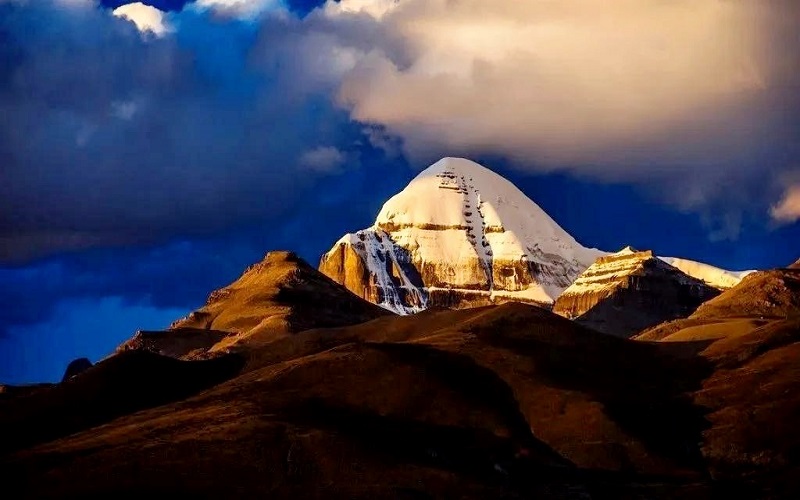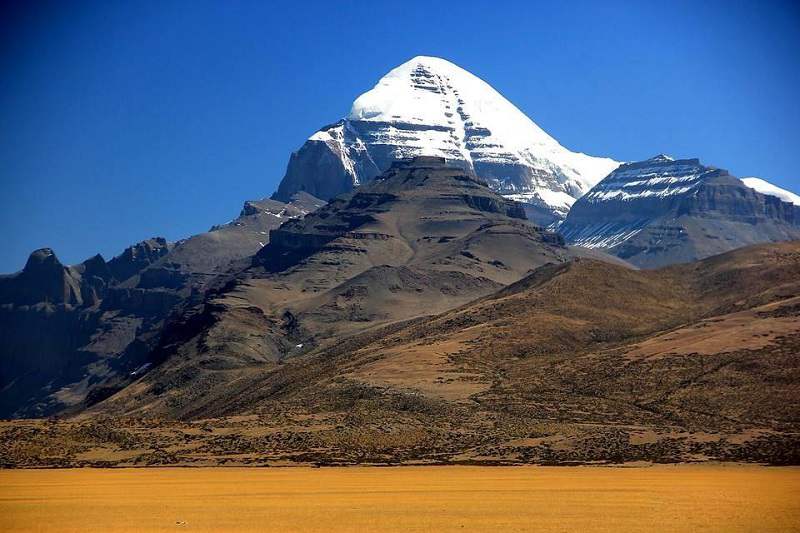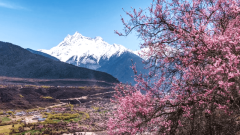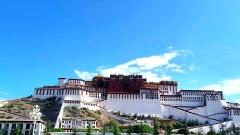Mount Kailash stands as one of the most enigmatic peaks on Earth, shrouded in layers of spiritual reverence, geological wonder, and mythic intrigue. Towering at 6,638 meters above sea level, this solitary mountain in western Tibet is far more than a lofty summit—it is a living symbol of cosmic order, a locus of pilgrimage for multiple faiths, and a subject of scientific and esoteric speculation. In this comprehensive exploration, we delve into the many mysteries and secrets that surround Mount Kailash: from its multitude of names across languages and religions, to its role as the “navel of the universe,” Shiva’s eternal meditation chamber, and even a purported man-made pyramid. Throughout, you will discover why millions of pilgrims and curious travelers make the arduous journey each year, and how a tour with China Dragon Travel can help you experience the full magic of this sacred Himalayan sentinel.
1. A Mountain of Many Names: Kailāsa, Gang Rinpoche, and Beyond
Few mountains carry the same weight of reverence and resonance as Mount Kailash. Across cultures and faiths, it is known by a myriad of names—each reflecting different aspects of its spiritual and symbolic significance:
- Kailāsa (Sanskrit): The “original” name, thought to derive from the Sanskrit “kelāsa,” meaning “crystal,” alludes to the mountain’s gleaming snow and ice. In Hindu tradition, Kailāsa is revered as the mythical home of Lord Shiva, the cosmic dancer and yogi supreme.
- Gang Rinpoche (Tibetan): Literally “Precious Jewel of Snows,” this name captures the mountain’s radiant peaks, which glint like turquoise and diamond under Tibetan sunlight. For Tibetan Buddhists, Gang Rinpoche invokes a sense of awe and protection.
- Kangri Rinpoche (Tibetan Buddhist): Used interchangeably with Gang Rinpoche, especially among local practitioners, Kangri Rinpoche emphasizes the mountain’s status as a “treasure” (Rinpoche) enfolded in snow (Kangri).
- Tisé (Tibetan): As locals often call it simply Tisé Mountain, the name points to the mountain’s ancient role as the source of legendary rivers—“ti” in Tibetan folklore means “water’s flower.”
- Mount Meru (Tibetan Cosmogony): In certain Buddhist texts, Mount Kailash is equated with the celestial Mount Meru, the mythical five-peaked mountain that stands at the center of the universe according to Buddhist, Hindu, and Jain cosmology.
- Shiva’s Abode (Hinduism): Known as the holy retreat of Lord Shiva and his divine family—Parvati, Ganesha, and Kartikeya—Kailash epitomizes spiritual stillness and yogic discipline in Hindu lore.
- Kanchenjunga of Purvapahar (Bön Tradition): The indigenous Bön religion, predating Buddhism in Tibet, refers to the peak with poetic terms like “Water’s Flower” or “Mountain of Sea Water,” indicating its primordial connection to life-giving rivers and oceanic origins.
This polyphony of names underscores how one natural formation can serve as a nexus of faiths, languages, and mythic frameworks. For pilgrims and tourists alike, learning these names is often the first step toward grasping why Mount Kailash occupies such a central place in Asia’s spiritual geography.
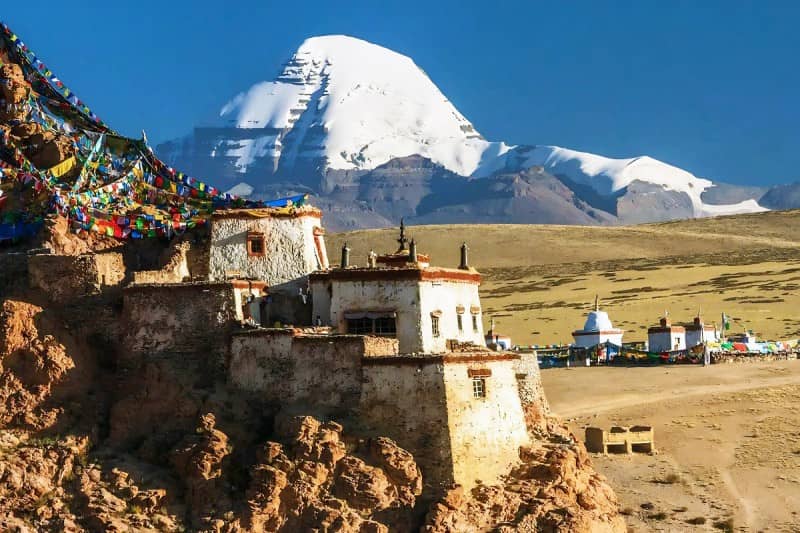
Mount Kailash
2. Cosmic Center: Kailash as Mount Meru and the Navel of the Universe
In Tibetan Buddhist cosmogony, Mount Kailash is more than a terrestrial high point—it is the very axis of existence. Paralleling the ancient Hindu concept of Mount Meru, the mythical mountain that anchors the four continents and channelizes cosmic energy, Kailash is deemed the “navel of the universe.”
- Mythical Mount Meru: In Buddhist, Hindu, and Jain cosmology, Mount Meru rises at the world’s center, its five peaks symbolizing the five elements (earth, water, fire, air, and space). Around its base lie concentric rings of oceans and continents, populated by gods, humans, and demons.
- Tibetan Interpretation: Tibetan lore holds that the earthly counterpart to Meru is none other than Gang Rinpoche. By placing Kailash at the heart of the Tibetan Plateau—surrounded by sacred lakes like Manasarovar and Rakshastal—the ancient sages reinforced the concept of Tibet as the microcosmic center of a macrocosmic universe.
- Spiritual Implications: Many Buddhists undertake the Kailash Kora (circumambulation) not only to accrue merit but also to symbolically affirm their connection to cosmic harmony. Completing a 53-kilometer clockwise kora around Kailash is said to align one’s karmic compass with universal dharma.
This cosmic centrality remains deeply embedded in Tibetan culture: monasteries like Zongpachen and pilgrimage sites around Kailash are considered earthly outposts for intercession between the spiritual and material worlds. As modern devotees traverse rugged trails, they walk not only on ancient stone paths but also on layers of mythic symbolism that reach back millennia.
3. Home of Lord Shiva: Kailash’s Place in Hindu Spirituality
For Hindus, Mount Kailash is synonymous with Lord Shiva, the regal deity often portrayed with matted hair, a crescent moon crown, and a third eye of transcendent wisdom. According to Shaivite tradition:
- Shiva’s Eternal Meditation: Kailash is the cosmic “crib” where Shiva—also addressed as Mahadeva (Great God)—sits in unbroken meditation. The mountain’s serene isolation provides the perfect setting for Shiva’s yogic contemplation, eclipsing all earthly distractions.
- Divine Family: Accompanying Shiva at Kailash are his consort, Parvati, and their two sons—Ganesha, the remover of obstacles, and Kartikeya, the warrior god. Their divine entourage includes Nandi, the sacred bull who serves as Shiva’s vehicle, and Bhairava, the fierce guardian of thresholds between worlds.
- Pilgrimage and Penance: Hindu tradition recounts tales of legendary sages—like Markandeya and Bhringi—who performed austere tapas (penance) at Kailash to gain Shiva’s blessings. Devotees still scrub the hard paths near the mountain’s base in hopes of cleansing their sins and achieving spiritual liberation (moksha).
- Aligning the Astral and Terrestrial: Many Hindus believe that because Shiva’s consciousness pervades Kailash, visiting the mountain yields not only cosmic alignment but also psychic purification. Pilgrims often recite sacred mantras—“Om Namah Shivaya”—while performing short prostrations along the kora.
Although Hindu pilgrims cannot always gain direct access to the outermost slopes—especially since the Indian government discontinued its Kailash pilgrimage scheme in the late 1980s—they continue to journey through Nepal’s Kerung/Langtang or Nyalam border to reach the base camp in western Tibet. The reverence for Kailash remains undiminished, linking the mountain’s snowy apex with Shiva’s boundless spiritual power.
4. Bridge Between Earth and Heaven: Kailash in Hindu, Buddhist, and Jain Beliefs
Across four major Dharmic faiths—Hinduism, Buddhism, Jainism, and Bön—Mount Kailash is seen as a cosmic doorway, a vertical axis connecting the earthly realm to the celestial. Common motifs include:
- Four Faces Pointing Cardinally: The mountain’s four broad, triangular faces align with north, south, east, and west—symbolically opening to every corner of existence. Pilgrimage routes approach Kailash from these cardinal points, honoring its omnidirectional influence.
- Hindu Legends of the Pandavas and Draupadi: In the epic Mahābhārata, the five Pandava brothers and their wife Draupadi journey to Kailash in pursuit of moksha. Along the way, four of the Pandavas and Draupadi ascend to heaven—even before reaching the summit—signifying that pure devotion can transcend even the highest physical barriers.
- Buddhist Pilgrimage: For Tibetan Buddhists, the kora around Kailash is not merely a trek but a powerful, meditative act that dissolves karmic bonds. Completing the full circumambulation is believed to erase the sins of countless lifetimes.
- Jain Austerity: Jain texts assert that Rishabhadeva, the first Tirthankara, attained spiritual liberation (kevalya) atop Kailash. Although Jain access is rarer today, the mountain still retains its sacred status among the community.
- Bön Creation Myths: Pre-Buddhist Bön tradition narrates that Kailash was once a lotus flower that transformed into a five-peaked mountain, each petal representing aspects of existence. For Bönpo practitioners, Kailash serves as a focal point for rituals that harmonize human consciousness with cosmic rhythms.
By acting as a “bridge” between earth and divinity, Kailash transcends individual faith boundaries. Pilgrims of different religions often follow the same dusty trails, offering barley flour and butter lamps at shared shrines—proof that the mountain’s magnetic draw exceeds sectarian divides.
5. The Face of Shiva: NASA’s Discovery and Pilgrims’ Reverence
One of Mount Kailash’s most stunning secrets is the appearance of Lord Shiva’s face on its sheer western flank. Noted by NASA scientists in satellite imagery and confirmed by seasoned pilgrims, this human-like visage emerges under certain light conditions, especially during early morning or late afternoon sun. Key details include:
- South Face to West Face Transition: Pilgrims begin the kora at Yamdwar on the mountain’s southern side. From there, the path turns westward toward Dirapuk. It is along this western corridor—between Dirapuk and the lesser-known Dögar shrine—that trekkers can catch their first glimpses of the “Shiva face.”
- Distinct Contours: Against the rock’s natural striations, shadows coalesce into features resembling a crown or jata (matted hair), a third eye, and a slight curve suggestive of a divine smile. While skeptics attribute the phenomenon to pareidolia (the tendency of the human mind to see patterns), many devout Shiva worshippers—known as Bhole Bhakts—insist that only the most devout eyes can perceive the face.
- Pilgrimage Significance: When pilgrims pause to prostrate at Dirapuk’s small shrine, they often crane their necks to pray toward the rock face, believing that Shiva himself watches over the circumambulation. Observing this “face” is said to confer special blessings: increased determination, inner purity, and an uplifted mind.
- Evening Phenomenon: During sunset, the western face glows golden, making the “Shiva face” even more pronounced. This ephemeral dance of light and shadow further cements its place in local lore: seeing the face at dusk is considered supremely auspicious, a divine gift for those who persevere on the long kora.
Whether natural or supernatural, the “face of Shiva” remains a potent emblem of how Mount Kailash merges sacred myth with observable phenomenon—inviting believers to see the divine etched in stone.
6. A Lone Sentinel: Kailash’s Remote, Unmatched Grandeur
Unlike the surrounding Himalayan ranges dense with thousands of peaks, Mount Kailash stands as a solitary colossus in the remote expanse of western Tibet. This isolation amplifies its visual and symbolic power:
- Geographical Lone Peak: Situated in the Ngari Prefecture of Tibet, Kailash rises without any comparably tall neighbors—no other mountain in a 100-kilometer radius approaches its 6,638-meter height. This stark solitude creates an unbroken silhouette that dominates the skyline, making Kailash visible from far-off valleys and low-lying plains.
- Spiritual Magnetism: The fact that Kailash is the lone, undefeated sentinel in a vast wilderness only adds to its mystique. Pilgrims who hike the 53-kilometer kora often describe an almost palpable “stillness” around the summit—no avalanches, no rockslides. Many attribute this to the mountain’s unique spiritual energy, which, according to local belief, keeps its slopes undisturbed.
- Minimal Human Footprint: Because of its remoteness—several days’ drive from major Tibetan towns—Kailash’s environment remains largely unspoiled. Travelers scarcely encounter fellow trekkers outside peak seasons, and the night skies brim with stars untainted by city lights.
- Geographic Significance: Strategically positioned near the heads of four great rivers (Indus, Sutlej, Brahmaputra, Karnali), Kailash’s isolation underscores how a single mountain can influence vast ecological and cultural regions downstream.
This remarkable seclusion challenges anyone who seeks to conquer Kailash, whether spiritually or physically. The mountain’s lonely dignity serves as a constant reminder of nature’s supremacy and the limits of human intervention.
7. Pyramid or Natural Peak? Theories of an Artificial Formation
Among the many puzzles surrounding Mount Kailash is the provocative claim that its flawless symmetry points to a man-made “vacuum pyramid.” Russian and American scientists have put forward arguments suggesting deliberate engineering:
- Perfect Geometric Symmetry: Observers note that the four faces of Kailash rise at steep, near-identical angles, converging to a pointed summit that resembles a massive pyramid. From certain angles, the slopes appear unnaturally uniform—almost as if cut and polished.
- Surrounding Pyramid Complex: Reports describe more than 100 smaller “pyramidal” outcroppings and subsidiary peaks around Kailash. Some measure anywhere from 100 to 1,800 meters in height—exceeding the tallest Egyptian pyramid at Giza (146 meters).
- Comparisons to Cathedral Architecture: Russian researchers have likened Kailash’s base and plateau to a cathedral’s foundation, noting horizontal terraces that resemble steps or platforms. These features, they argue, could be remnants of an ancient, advanced civilization that intended Kailash as a monumental edifice rather than a purely natural peak.
- Vacuum Pyramid Hypothesis: Proponents claim that Kailash’s internal structure may conceal voids—“vacuum chambers”—akin to lubrication systems found in smaller, early pyramids elsewhere. They speculate that these hidden cavities could regulate ice flow or internal stress, preventing avalanches and maintaining the mountain’s pristine snowcap.
- Counterarguments: Geologists counter that Kailash sits on a thrust fault created by the ongoing collision of the Indian and Eurasian plates. The mountain’s shape, they say, results from millions of years of tectonic uplift and uniform glacial erosion. Its four-sided symmetry is thus a coincidence of natural forces rather than intentional design.
Whether Kailash is an “ancient superstructure” or a stunning example of geological artistry, the debate only adds another layer of awe. Pilgrims who trek around the base often pause at strategic viewpoints, convinced that they sense deliberate proportions and hidden patterns beyond ordinary mountain shapes.
8. The Eternal Snowcap: Unmelted Ice at 6,638 Meters
Walk around Mount Kailash in any season, and you’ll notice an unbroken crown of white atop its summit. Even during the height of summer, when surrounding peaks show signs of snowmelt, Kailash’s top remains cloaked in pristine ice. This unchanging snowcap holds both scientific intrigue and spiritual symbolism:
- Glacial Preservation: At 6,638 meters, Kailash’s summit temperature rarely exceeds freezing. Combined with the mountain’s insular position—shielded from monsoon surges—its snow doesn’t experience the same melt cycles that affect adjacent peaks.
- Unique Microclimate: Given its isolation, the mountain benefits from a cold, dry microclimate. Precipitation arrives mostly as high-altitude snow, which compacts and darkens over time into a reflective ice crust resistant to direct sunlight.
- Spiritual Metaphor: For pilgrims, Kailash’s permanent snowcap represents unchanging purity and the timeless nature of divine truth. The Sanskrit name “Kailāsa” (crystal) highlights this idea: an undiluted, clear essence that transcends earthly flux.
- Pilgrimage Timing: Since the summit always remains covered, there is never a “best time” to see a snow-free peak. Instead, travelers often recount how the sun’s light—at sunrise or sunset—plays off the ice, turning it brilliant gold or pink, adding to Kailash’s “jewel-like” reputation.
This eternal blanket of snow has inspired countless songs, poems, and prayers. Devotees believe that bathing in the nearby Lake Manasarovar (elevation 4,588 m) during pilgrimage season is imbued with the same purifying power as touching Kailash’s frigid glaciers—both authenticating the mountain’s status as a living, unchanging manifestation of the divine.
9. The Unconquered Summit: Why Kailash Remains Unclimbable
At first glance, a 6,638-meter peak does not rank among the seven highest in the Himalayas. Yet, unlike nearby Everest (8,848 m) or Kanchenjunga (8,586 m), Mount Kailash has never been summited by modern climbers—and according to local legend, only one ancient monk ever reached its pinnacle. Several factors contribute to Kailash’s untouchable status:
- Sacred Taboo: Tibetans, Hindus, Jains, and Bön practitioners unanimously regard Kailash’s summit as off-limits. The mountain is revered as a living embodiment of divine presence—messing with its summit would, according to myth, anger the gods and invite calamity.
- Milarepa’s Ascent: The most famous tale involves the eighth-century Buddhist saint Milarepa, who is said to have briefly glimpsed the summit during deep meditation. According to legend, he left a single footprint in the soft snow before descending; thereafter, no mortal dared repeat his feat.
- 20th-Century Expedition: In the 1930s, a joint expedition of Soviet and British scientists landed a group of climbers in the vicinity with the aim of evaluating Kailash’s geological secrets. Despite extensive surveying, a local Tibetan Lama (high priest) warned them to abandon their ascent—or face dire karmic repercussions. Four members of that team died under mysterious circumstances within two years, further cementing Kailash’s reputation as “unclimbable.”
- treacherous Terrain: While not technically the highest, Kailash’s steep, smooth granite faces—coupled with unpredictable weather and blizzard-like conditions—make any ascent extremely perilous. The absence of fixed guides, porters, or base camps (out of respect for local taboos) further dissuades modern climbers.
- Legal Protections: Tibetan authorities have officially closed Kailash’s summit to climbers, reinforcing centuries-old spiritual injunctions. In effect, the mountain remains a “freeze-dried” high altar—accessible only for circumambulation, not summit conquest.
Thus, Kailash’s allure lies precisely in its inviolability. Travelers may trek around its base, offering prayers at designated shrines, but the apex itself remains a celestial realm, untouched by human ambition.
10. The Sacred Kora: A Three-Day Odyssey of Purification
Perhaps the most defining rite for any visitor to Mount Kailash is the Kailash Kora—a ritualized circumambulation that loops around the mountain’s base in a 53-kilometer clockwise circuit. This pilgrimage is not simply a hike, but a profound spiritual journey aimed at:
- Karmic Purification: According to Tibetan Buddhist belief, completing one kora wipes away the sins of three lifetimes; completing three consecutive kora (three days in a row) can lead to immediate enlightenment or liberation (nirvana).
- Miraculous Aid: Traditional lore holds that guides and supporters often report receiving hidden help—such as footsteps set into the most difficult sections or sudden gusts of wind clearing a path—especially for pilgrims who chant mantras faithfully.
- Cultural Immersion: Throughout the kora, pilgrims—called “Kailashites”—spin prayer wheels, chant “Om Mani Padme Hum,” and leave heaps of mani stones (carved rock with sacred inscriptions) at shrines like Dirapuk and Drolma-La Pass (5,630 m). These stone mounds grow daily, symbolizing collective merit.
- Day-by-Day Breakdown:
- Day 1 (Yamdwar to Dira Puk / 12–15 km): Starting at Yamdwar (4,575 m), the mouth of the Yangtze River (known locally as “Dri Chu”), pilgrims pass through Panduk Monastery, entering the kora proper. The final stretch reaches Dirapuk (4,900 m), where a small cave shrine lies directly under Kailash’s western face—home to the “Shiva face” phenomenon.
- Day 2 (Dirapuk to Zuthulpuk / 18–20 km): The second day crosses the highest point, Drolma-La Pass (5,630 m), a grueling ascent of nearly 700 meters. On a clear day, Everest and Mansarovar come into view. Descending to Zuthulpuk’s hot springs provides sore-footed relief. Devotees often submerge in these geothermal waters, believing they carry cleansing power.
- Day 3 (Zuthulpuk to Yamdwar / 20 km): The final leg meanders along the eastern flank, passing the serene Zhang-mChung Lake and eventually rejoining the starting point at Yamdwar. The sense of completion often brings tears of joy—pilgrims have traversed both physical and karmic obstacles.
- Ritual Observances: In every direction, small prayer flags flutter on cairns; strings of prayer flags—lungta—span the passes to bless the four cardinal winds. As daybreak illuminates the mountain, many prostrate fully at each prayer flag cluster, marking an act called “full-body prostration” that can extend one’s kora duration from three to five or more days.
For many, spending three days on this track is a once-in-a-lifetime test of devotion, resilience, and faith—one that reshapes perspective long after descending from Tibet’s high desert.
11. Wellspring of Four Great Rivers: Indus, Sutlej, Brahmaputra, and Karnali
Few mountains on Earth rival Kailash’s hydrological significance. Nestled near the twin lakes of Manasarovar and Rakshastal, Kailash’s southwestern slope gives rise to four of Asia’s most important rivers:
- Indus River (Singgye Khabub in Tibetan): One of the longest rivers in Asia, the Indus flows from Tibet into Gilgit-Baltistan (Pakistan), meandering 3,180 kilometers before emptying into the Arabian Sea. Its basin sustains millions in Pakistan’s Punjab region—a direct link from Kailash’s glacial snows to South Asian wheat fields.
- Sutlej River (Langqên Zangbo in Tibetan): Originating near Lake Rakshastal west of Kailash, the Sutlej carves a path through the Himalayas into India’s Himachal Pradesh and Punjab states. As a major tributary of the Indus, the Sutlej’s headwaters exemplify how a single mountain can send lifeblood to multiple, far-flung regions.
- Yarlung Tsangpo / Brahmaputra (Dri Chu / Bromo in Tibetan): Flowing east from Kailash’s northern side, this mighty river plunges through the world’s deepest canyon—Yarlung Tsangpo Grand Canyon—before entering India as the Brahmaputra and ultimately merging with the Ganges Delta in Bangladesh. The Brahmaputra’s annual monsoon floods are crucial for agriculture but also underscore the imperative of Himalayan water management.
- Karnali River (Macha Khabub in Tibetan): One of Nepal’s longest and most pristine rivers, the Karnali originates from the northern slopes of Kailash. Hosting endemic fish species and famed for whitewater rafting, the Karnali serves both ecological and economic roles in the remote Far-Western region of Nepal.
For local communities, these rivers are embodiments of divine generosity; the life they bring to parched plains is often celebrated in festivals and seasonal rituals. Observing where these waterways depart from Kailash’s hidden valleys highlights how a single peak can influence entire civilizations—offering a microcosm of the mountain’s universal centrality.
12. Gate to Shambhala: Kailash’s Link to the Mythical Pure Land
Hidden amid the swirling mists of legend is Shambhala (also spelled “Shambala” or “Shangri-La”), an otherworldly realm said to lie somewhere between the Himalayas and the Gobi Desert. In Tibetan Buddhist tradition:
- Shambhala as Pure Land: Shambhala is depicted as a utopian kingdom where all inhabitants have attained enlightenment. Classic texts like the Kalachakra Tantra describe it as a land of perpetual peace, wisdom, and spiritual abundance.
- Kailash’s Proximal Role: While no one has definitively located Shambhala on any map, many practitioners believe that Kailash—and its hidden valleys—serve as an earthly “gateway” to this hidden realm. Ancient texts speak of secret passages, subterranean caverns, and meditative retreats inaccessible to ordinary mortals.
- Tibetan Siddhas and Yogic Masters: According to folklore, accomplished Siddhas (enlightened beings) and Tantric adepts still dwell in Shambhala, meditating near subterranean lakes and crystal palaces—accessible only to those with exceptionally pure devotion.
- Russian & Western Esoteric Interest: From Helena Blavatsky’s Theosophical Society to modern New Age seekers, Shambhala has captured the Western imagination as a Himalayan equivalent of Atlantis. Speculative maps and psychic visions have located Shambhala near Kailash’s remote glacial cirques—though mainstream academia treats such claims with skepticism.
Whether literal or allegorical, the Shambhala myth reinforces Kailash’s status as a spiritual threshold—an axis not only between earth and heaven, but between the seen and unseen worlds. Pilgrims who press on after completing their kora often say they experience an “aliveness” in the high passes, as if reality itself has shifted—perhaps a fleeting brush with Shambhala’s hidden glow.
13. The Central Axis: Kailash as Axis Mundi, Earth Tree, and World Pillar
The concept of Axis Mundi—the world’s central pivot—appears in many cultures: the Mesopotamian Ziggurat, the Norse Yggdrasil (World Tree), and Hindu Mount Meru all symbolize a cosmic center where heaven and earth converge. Mount Kailash occupies this role in Tibetan and Vedic lore:
- Vedic and Puranic References: Hindu scriptures like the Vishnu Purana and Ramayana describe a cosmic mountain at the heart of creation, linking humankind to divine realms. In these texts, Kailash’s silhouette becomes synonymous with a world axis that upholds the heavens.
- Alignment Studies: Modern GIS (Geographic Information System) analyses and Russian-American research claim that Kailash sits at equal great-circle distances—6,666 kilometers—from both the North Pole and Stonehenge in England. Some go farther to associate it with other ancient sites—like the pyramids of Giza (6,666 km to the south). While such numerical alignments could be coincidental, they feed into the notion that Kailash functions as a planetary fulcrum.
- The World Tree Symbolism: Just as Yggdrasil connects earth, sky, and underworld, Kailash stands between the high-altitude domain of spirits and the lowland realms of humans. Monks and pilgrims often carve prayer flags into trees and rocks on its slopes, symbolically “planting” branches of the world tree in sacred ground.
- Pilgrimage as Axis Activation: Every round of the kora can be seen as “activating” the axis. By walking clockwise—fashioned after the sun’s path—pilgrims participate in a ritual that reaffirms the cosmic order. Tibetan painters (thangka artists) often depict Kailash with concentric rings of rivers and continents, further emphasizing its central role in the universe’s architecture.
This multi-layered symbolism elevates Mount Kailash beyond mere geography—transforming it into a living mandala that unites body, mind, and cosmos. Whether viewed through a religious lens or a geomantic perspective, Kailash’s axis mundi status reveals the mountain’s unparalleled capacity to inspire reverence across millennia.
14. Sunset Mysteries: Swastika and Om Parvat Phenomena
As twilight descends on Mount Kailash, the mountain’s shadow can cast a Swastika-shaped silhouette across adjacent ridges—a spectacle that holds deep sacred significance for Hindus and Jains. Meanwhile, melting snow can produce an “Om” symbol on Om Parvat, a nearby peak visible from the axis formed by Kailash-Karni area:
- Swastika Shadow on Kailash: The Swastika (in Sanskrit, “svastika,” meaning “well-being” or “good fortune”) is an ancient, auspicious symbol in many Eurasian traditions. When the sun sets behind Kailash’s southwest face, the interplay of ridges and gullies can create a four-armed Swastika shadow that moves in tandem with the fading light. Hindus view this as a direct blessing from the mountain—an affirmation of life’s inherent prosperity.
- Om Parvat’s Miraculous Snow Formation: About 20 kilometers from Kailash lies Om Parvat, so named because the snow deposition on its southern face often resembles the sacred Om syllable—considered the primordial sound of creation in Hindu cosmology. The perfect curvature forms when windblown snow settles in specific ledges and grooves, producing an ephemeral “ॐ” that devotees eagerly photograph.
- Pilgrim Testimonies: Witnessing either the SwastikaShadow or the “Om” symbol is seen as an extraordinary sign—pilgrims plan multiple nights near strategic viewpoints to increase their chances. Many recount how, upon seeing these phenomena, they felt a palpable shift in their consciousness—an experiential affirmation that the mountain’s spiritual power is very real.
- Optimal Viewing Conditions: Early October to November, when the air is crisp and moisture is low, provides the clearest views. Pilgrims often combine stops at Tirthapuri or Oma village to gaze upon Om Parvat. Similarly, the Swastika shadow is best observed from the Valley of the Gods en route to Zuthulpuk.
These sunset phenomena epitomize how Kailash’s mysteries are not static; they emerge through a combination of time, space, and faith. Each year, fresh images and videos of these symbols circulate online, drawing new waves of seekers who yearn to stand beneath those fleeting, divine projections.
Kailash’s Enduring Magnetism
Mount Kailash defies simple categorization. Is it a geological wonder shaped by tectonic forces? A monolithic shrine consecrated by four major world religions? A conduit to hidden realms like Shambhala? Or could it even be an ancient “vacuum pyramid” defying natural explanation? The answer likely lies in the interplay of all these perspectives.
When pilgrims set out on a three-day kora, they often report that Kailash’s silence “speaks” to them. The mountain’s solitude and symmetry, its perennial crown of snow, and its storied legends combine to form an experience that transcends ordinary adventure travel. Whether you walk for three days around its base, trace its “Shiva face” in the shifting light, or simply meditate on its four sacred faces, you become part of a living tapestry woven over thousands of years.
If you feel called to explore Mount Kailash’s myriad mysteries—its sacred geometry, its cosmic centrality, and its ever-present invitation to transcendence—consider partnering with an experienced local operator. China Dragon Travel has guided thousands of pilgrims and travelers through Tibet’s remotest terrains. Their expert Tibetan guides manage every logistical detail—from securing your Tibet Travel Permit to arranging acclimatization itineraries—so you can focus on absorbing Kailash’s profound energy. Whether your aim is to experience the Shiva face at Dirapuk, witness the Om on Parvat at sunset, or complete a full Circumambulation, China Dragon Travel tailors each journey to meet your spiritual and logistical needs.



